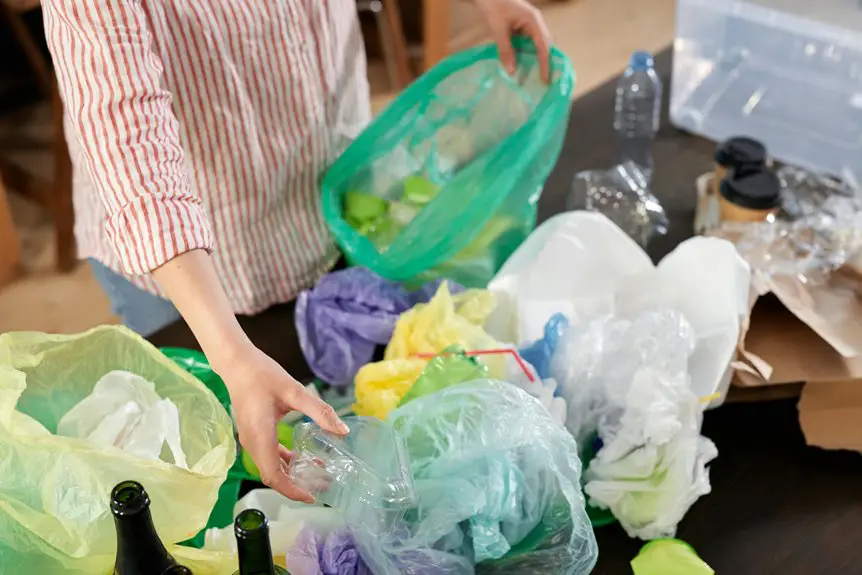You can recycle nonwoven polypropylene bags, but it depends on your local recycling facility’s policies and equipment. These bags are made from durable, lightweight material that often resists wear but can cause sorting challenges and contamination issues in recycling centers. Many places don’t accept them curbside, so you might need to check specific drop-off locations or follow special preparation steps. If you want to understand more about handling these bags and eco-friendly options, keep exploring further.
Table of Contents
Key Takeaways
- Nonwoven polypropylene bags are recyclable but often rejected due to contamination and sorting difficulties at many recycling facilities.
- These bags are lightweight and flexible, which complicates their handling in standard recycling equipment.
- Checking with local recycling centers is essential to confirm if they accept nonwoven polypropylene bags.
- Proper cleaning and bundling may be required before recycling to improve acceptance chances.
- Reusing nonwoven polypropylene bags is typically more environmentally beneficial than recycling them.
Understanding Nonwoven Polypropylene Material
Nonwoven polypropylene is a versatile material made by bonding polypropylene fibers together without weaving or knitting. When you handle it, you’ll notice it feels sturdy yet lightweight, thanks to its unique construction.
Nonwoven polypropylene combines strength and lightness through bonded fibers, not weaving or knitting.
This material is water-resistant and durable, which helps it stand up to repeated use. Unlike traditional fabrics, nonwoven polypropylene doesn’t unravel or fray, so it maintains its shape over time.
It’s also resistant to many chemicals and doesn’t degrade easily under normal conditions. Because it’s thermoplastic, you can heat it to reshape or bond it further.
Understanding these properties gives you a clearer picture of why nonwoven polypropylene is popular for reusable bags and other applications, especially when durability and moisture resistance are important factors.
Common Uses of Nonwoven Polypropylene Bags
You’ll find polypropylene bags everywhere because their durability and water resistance make them ideal for many uses.
When you shop, you probably use them as reusable grocery bags—they hold heavy items without tearing and resist moisture from fresh produce. You might also see these bags in promotional events; companies print logos on them for giveaways that last.
Beyond shopping, they serve well for storage, protecting clothes or documents from dust and dampness. You can carry gym gear or picnic supplies in them, enjoying their lightweight yet sturdy design.
Since they’re easy to clean, you might use polypropylene bags repeatedly without worry. Their versatility and practicality make them popular in everyday life, from errands to casual outings.
Challenges in Recycling Nonwoven Polypropylene Bags
Although polypropylene bags are widely used, recycling them poses several challenges.
First, these bags often get contaminated with food residue or dirt, making the recycling process less efficient.
You might also find that nonwoven polypropylene bags are lightweight and flexible, which causes problems in sorting machines at recycling facilities—they can get tangled or misidentified.
Additionally, many facilities aren’t equipped to handle this specific type of plastic, so even if you want to recycle them, your local center mightn’t accept these bags.
Finally, the lack of clear labeling on these bags means you mightn’t always know if they’re recyclable.
Understanding these challenges helps you realize why recycling nonwoven polypropylene bags isn’t as straightforward as it seems.
How to Identify if Your Local Facility Accepts These Bags
Recycling polypropylene bags can be tricky, especially when local facilities vary in what they accept. To find out if your local recycling facility takes these bags, start by checking their website or calling their customer service. Look for specific terms like “nonwoven polypropylene” or “plastic bags.” Also, ask about any preparation requirements, such as cleaning or bundling bags.
Here’s a quick way to organize your findings:
| Facility Name | Accepts Polypropylene Bags? | Notes/Requirements |
|---|---|---|
| City Recycling | Yes | Bags must be clean and dry |
| County Center | No | Only accepts rigid plastics |
| Green Drop | Yes | Bundled in groups of 10 |
| Eco Hub | No | No soft plastics accepted |
This helps you quickly assess where to drop off your bags.
Alternative Disposal and Repurposing Options
When your local facility doesn’t accept nonwoven polypropylene bags, consider alternative disposal or repurposing options to keep them out of landfills.
You can reuse these bags as storage solutions for items like garden supplies, toys, or laundry. Their durability also makes them great for carrying groceries or packing materials.
If you’re crafty, cut the bags into strips and weave them into mats or use them as protective covers for plants in frost-prone areas.
Additionally, some specialty recycling programs or stores accept these bags even if your local facility doesn’t. Check online for drop-off locations or mail-in recycling services.
Environmental Impact of Reusing vs. Recycling
When you reuse nonwoven polypropylene bags, you cut down on waste and save energy compared to recycling.
Recycling these bags can be tricky due to sorting and contamination issues, which adds complexity to the process.
Understanding these environmental trade-offs helps you make smarter choices about how to handle your bags.
Benefits of Reusing
Although recycling nonwoven polypropylene bags helps reduce waste, reusing them offers even greater environmental benefits. When you reuse these bags, you cut down on the energy and resources needed to produce new ones.
Plus, it lessens the demand for recycling facilities to handle the load, reducing overall environmental strain. By choosing to reuse, you directly minimize pollution and landfill buildup.
Here’s why reusing is a smart choice:
- Saves raw materials by extending the life of each bag
- Reduces carbon footprint compared to recycling processes
- Prevents bags from becoming litter or taking up landfill space
Recycling Process Challenges
Since recycling nonwoven polypropylene bags involves complex processes, you might find it less straightforward than simply reusing them.
These bags often contain contaminants like dirt or adhesives that complicate recycling. You also need specialized facilities equipped to handle nonwoven polypropylene, which aren’t available everywhere.
Sorting these bags from other plastics is another challenge, as mixed materials can reduce the quality of recycled output. Additionally, the recycling process consumes energy and resources, so it’s not always the most eco-friendly option compared to reusing.
When you consider these hurdles, you’ll see why many recommend extending the life of these bags through reuse before recycling. Understanding these challenges helps you make informed choices about managing your nonwoven polypropylene bags responsibly.
Environmental Trade-Offs
Dealing with the challenges of recycling nonwoven polypropylene bags naturally leads you to evaluate the environmental benefits of reusing versus recycling.
Reusing bags reduces waste and energy consumption since you don’t need new materials or processing. However, recycling turns old bags into new products, cutting down on raw material extraction.
You’ll want to reflect on:
- Energy use: Reusing saves more energy than recycling.
- Waste reduction: Recycling still produces some waste residue.
- Resource conservation: Recycling helps preserve non-renewable resources.
Frequently Asked Questions
Are Nonwoven Polypropylene Bags Safe for Food Storage?
You can safely store food in nonwoven polypropylene bags since they’re generally food-grade and resistant to moisture. Just make sure they’re clean and dry before use to keep your food fresh and avoid contamination.
How Durable Are Nonwoven Polypropylene Bags Compared to Plastic Bags?
You’ll find nonwoven polypropylene bags last up to 10 times longer than typical plastic bags. They resist tearing and stretching, making them more durable for repeated use and heavier loads, saving you money and reducing waste.
Can Nonwoven Polypropylene Bags Be Composted?
You can’t compost nonwoven polypropylene bags because they’re made from synthetic materials that don’t break down naturally. Instead, focus on reusing them or finding a recycling program that accepts polypropylene to reduce waste effectively.
Do Nonwoven Polypropylene Bags Release Harmful Chemicals When Burned?
You should know burning nonwoven polypropylene bags releases harmful chemicals like carbon monoxide and formaldehyde. Studies show burning plastics contributes to 14% of global toxic air pollutants, so avoid incinerating these bags to protect your health.
What Is the Typical Lifespan of a Nonwoven Polypropylene Bag?
You can expect your nonwoven polypropylene bag to last about 12 to 24 months with regular use. Its durability depends on how often you use it and how well you care for it.
- Does Chiffon Fabric Stink - July 15, 2025
- Does Chiffon Fabric Affect the Economy - July 15, 2025
- Does Cotton Fabric Have a Nap - July 15, 2025







